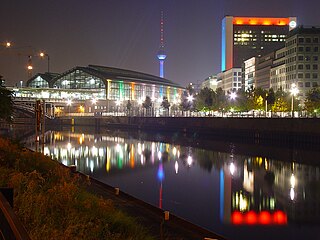
The Berlin S-Bahn is a rapid transit railway system in and around Berlin, the capital city of Germany. It has been in operation under this name since December 1930, having been previously called the special tariff area Berliner Stadt-, Ring- und Vorortbahnen. It complements the Berlin U-Bahn and is the link to many outer-Berlin areas, such as Berlin Brandenburg Airport. As such, the Berlin S-Bahn blends elements of a commuter rail service and a rapid transit system.

Berlin-Pankow is a station on the Berlin–Szczecin railway, situated in Berlin's Pankow district. It is served by the S-Bahn lines S2, S8 and S26 and is the northern terminus of the U-Bahn line U2.

The S10 was a line number used by the Berlin S-Bahn from June 1991 until December 1999. The line operated solely in the former East Berlin and was replaced by the S8 for the northern part of the route and the S47/S9 for the southern routing.

Berlin-Wittenau (in German S-Bahnhof Berlin-Wittenau, officially Wittenau (Wilhelmsruher Damm)) is a railway station in the Wittenau district of Berlin, Germany. It is served by the Berlin S-Bahn and numerous local buses. It is also the northern terminus of the Berlin U-Bahn line U8.
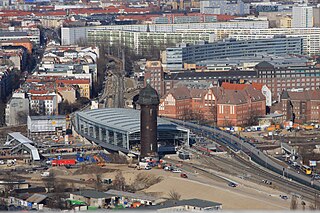
Berlin Ostkreuz station is a station on the Berlin S-Bahn suburban railway and the busiest interchange station in Berlin. It is in the former East Berlin district of Friedrichshain, now part of the borough of Friedrichshain-Kreuzberg. A smaller part of the station is in Rummelsburg, part of the borough of Lichtenberg. The station is a Turmbahnhof with the Berlin–Frankfurt (Oder) railway and the Prussian Eastern Railway on the lower level and the Berlin Ringbahn on the upper level. It is used by a total of around 235,000 passengers every day on eight lines, entering or leaving.

Oranienburg is a railway station located in Oranienburg, Germany. The station was opened in 1877 is located on the Berlin Northern Railway and the now closed Nauen–Oranienburg railway and Oranienburg–Velten railway. The train services are operated by Deutsche Bahn and Niederbarnimer Eisenbahn.

Lehnitz is a railway station in the district of Lehnitz, Oranienburg, Germany. It is served by route S1 of the Berlin S-Bahn, with trains in both directions stopping every 20 min during the hours of operation.
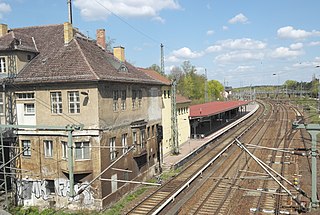
Birkenwerder is a railway station in the town of Birkenwerder, Brandenburg, Germany. The station lies of the Berlin Northern Railway and the train services are operated by Deutsche Bahn including Berlin S-Bahn services.

Berlin-Waidmannslust is a railway station in the neighbourhood of Waidmannslust, in the city of Berlin, Germany. It is served by the Berlin S-Bahn and by several local buses.
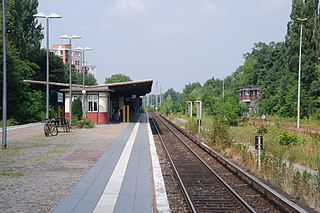
Berlin-Schönholz railway station is a railway station in Berlin, Germany. It is located on the Berlin Northern Railway line in the district of Reinickendorf, though it is named after the adjacent Schönholz quarter of the neighbouring Pankow district. From here, the Kremmen Railway branch line leads to Hennigsdorf and Kremmen. The station is served by S-Bahn trains and local bus lines, and is protected as a listed monument.

Berlin Bornholmer Straße is a railway station in the Prenzlauer Berg district of Berlin, Germany. It is served by the Berlin S-Bahn and the M13 and 50 lines of the Berlin Straßenbahn.
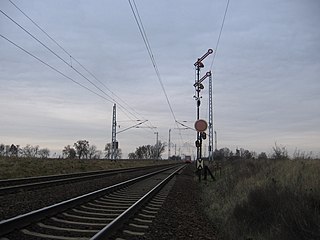
The Berlin Northern Railway is a 223-kilometre-long main line route, that runs from Berlin via Neustrelitz and Neubrandenburg to Stralsund on the Baltic Sea coast. Nowadays, long-distance and regional traffic on the Nordbahn is routed at Hohen Neuendorf onto the Berlin Outer Ring to the Karower Kreuz and on to Berlin Main Station or Berlin-Lichtenberg.

Hennigsdorf is a railway station in the Oberhavel district of Brandenburg, located in the town of Hennigsdorf. It is the northern terminus of the S-Bahn line S25 as well as a station for regional passenger trains and freight services.
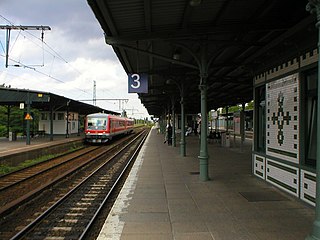
Berlin-Schöneweide is a railway station in Niederschöneweide, part of the Treptow-Köpenick borough of Berlin. It is served by the S-Bahn and regional trains, buses and trams. It was a terminal for long-distance trains until 2011.

The Wannsee Railway is a suburban railway in Berlin running from Potsdamer Platz via the Ring line station of Schöneberg to Wannsee station on Großer Wannsee, a lake after which it is named. Today it is a section of the Berlin S-Bahn line S1.
The Anhalt suburban line is a suburban railway in Berlin and Brandenburg. It originally ran from Potsdamer Ringbahnhof in Berlin over the Berlin–Halle railway. With the opening of the Berlin Nord-Süd Tunnel in 1939, this service was abandoned. Subsequently, the electric services ran to the south parallel with the long-distance tracks of the Anhalt Railway. Its terminus was at Berlin-Lichterfelde Ost until the 1940s. In 1943, it was extended to Lichterfelde Süd for electric trains and to Ludwigsfelde for steam trains. The construction of the Berlin Wall in 1961 stopped services at the outskirts of Berlin. In 2005, a new Berlin-Lichterfelde Süd–Teltow Stadt S-Bahn line was opened.

The Berlin outer ring is a 125 km (78 mi) long double track electrified railway, originally built by the German Democratic Republic to bypass West Berlin in preparation for the building of the Berlin Wall during the division of Germany. It was developed by East Germany for economic, transport policy, and military reasons between 1951 and 1961 and included parts of some older lines.
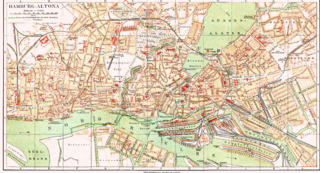
The Hamburg-Altona link line is a railway line in Hamburg, Germany. Nowadays, it connects the lines from the north and northwest of Hamburg and Altona station with Hamburg Hauptbahnhof and the lines to the southwest, south and east. Initially designed as a freight line only, it is now one of the busiest lines in Germany. It includes the suburban tracks of the Hamburg Stadtbahn, originally the core of the Hamburg S-Bahn.

S15 is a planned second north-south route for the Berlin S-Bahn, which will connect Berlin Hauptbahnhof to the Berlin Ringbahn to both north and south. The first section is under construction and is expected to go into operation in 2024.

The Berlin S-Bahn began on 8 August 1924 with the first section from Stettiner Vorortbahnhof to Bernau using steam locomotives. On 13 August 1961 it was broken up when the Berlin Wall was built, resulting in two sections: the eastern part and the western part. The western part experienced a massive strike which resulted in closure of several stations, after declining use. Attempts were made to reopen at various times but in the end, only three lines were finally opened after the strike. Since 9 November 1989, when the Berlin Wall was opened, the Berlin S-Bahn began to expand rapidly with their budgetary costs.






















